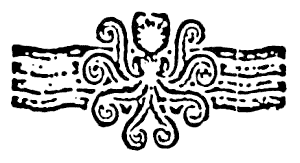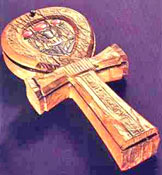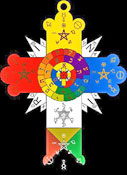|



by Tracy R. Twyman
Oct 23, 2004
from
DragonKeyPress Website

The catalogue mark
given to Secret Dossiers
by the Bibliotheque
Nationale
The Greek philosophers were ignorant of the source of the knowledge
contained in their mythology. Aristotle said that it came from
the
barbarians, and holy Clement of Alexandria expressed the same
opinion. The word “barbares” is without a doubt closer to the Hebrew
word “Ber.” It is remarkable then that the Hebrew root “BER” means
“source”, an idea which is associated with that of an “origin.” (1)
Cesar notes that the Welsh Druids used writing of a Greek nature. We
are thus incited to see in Greek the writing of those who, along
with bronze, brought to the Mediterranean basin their worship and
their gods. It is also on these premises that they would have
conceived of the myths collected by the Greeks.
The men of prehistory had, to our knowledge, been inclined towards
the constellations of the North, and to the Great Bear (Grand Ourse) (2),
the one named and illustrated by the ancients. However, the word
“Aour” means light in Hebrew. The Great Bear is the great light, but
what word is it in our language? The answer is rather unexpected and
I give it without any reservations. Indeed, in Hebrew, as always,
the name of the animal called “the Bear” is “CHR TZ”, where one
discovers the word Christ.(3)
The astonishing mystery is a source of constant admiration when one
sees the relationships between the words, or the words by which the
verbs manifest!
Is it not already obvious that to speak a poor French dialect that
originated elsewhere will not make mankind become one single family,
and that it is the call to transformation alone which must bring
together the people into a single herd, led only by a single pastor?
As for the red flag, it is that of the Sacred Heart. Previously, a
red cloth was thrown derisively on the shoulders of Jesus in front
of Pilate, who then scoffed at his alleged office of King of the
Jews. And in the Apocalypse, XIX, 13, it is covered in a red cloak
that Christ returns in royal majesty. Red is indeed the crimson
color of the kings, this primitive race having given to the world
its rules and its laws, because all the people of Europe living on
the banks of the Atlantic Ocean can claim the priestly heritage.
Red is the color of the primitive solar religion. If the skeletons
of the Celtic epoch were buried in red earth, then the Peaux-Bouges,
who polish the body in red in certain instances, are presently heirs
to the Celtic tradition.
The color red is that of Hermes (that of the kermes). The
black
color (of anarchy) must, in the transformations of the substance
principle, transform itself into a red color. The red flag has,
besides other things, a long history which is connected to the
universal Tradition in general and with that of France in
particular.
When the Roman Empire extended itself down into Scotland, a red
standard called the “vexillum” or “cantabrun” was used as the
exclusive insignia of the more venerated armies. During battle, it
was carried at the head of the troops. The guard was entrusted to
fifty Praetorians chosen from among the strongest and bravest men.
This standard consisted of a crossed lance made from a stick, from
which fell a crimson veil with fringes of gold. The pole was
surmounted with an eagle made of gold. After the famous vision of
the monogram of Christ (not the cross like they mistakenly say) and
his apparition in the Sun - a vision of that place surrounded by
Autumn, which was accompanied by a voice saying to him, “By this
sign you will overcome” - the emperor Constantine placed this
monogram at the top of the pole of the red standard, consequently
giving it the significant name of “labarum.”
In fact, the monogram of Christ, about which they little question
themselves, contains the necessary elements and symbolic systems
sufficient to penetrate the labyrinth. A red flag was thus the first
French flag, and this idea brings to mind the famous oriflamme
(golden flame) preserved in the basilica of Saint-Denis, which on
many occasions led the French to victory with the cry of “Montjoie
Saint-Denis” (4), and
which was a red banner cut out in points at the bottom, spangled
with lily of gold, and bordered with a fringe of gold.
This standard was originally the banner of the Abbey of Saint Denis.
Its color indicates that of the wine devoted to Dionysus, because
between Saint Denis and Dionysus there is an etymological
relationship. The holy Denis lost his head, having been decapitated.
Dionysus lost his heart. However, he who discovers the relationship
which exists between the two legends has penetrated one of the
mysteries of esotericism.
Dionysus is the divine spirit of evolution throughout the universe,
the radiant spirit, alive with intelligence. We know that he was
torn apart by the Titans, who devoured his members and interred his
heart, but that Minerva (Athena) carried this heart into the sky,
captioning an entire teaching of the Orphic tradition. The word
Orpheus contains “Or-phos.” It is it a word composed of two words,
the one Hebrew and the other Greek, and significantly both mean
“light.”
The Devotion of the
Sacred Heart

Illustration
of the Sacred Heart from Secret Dossiers.
In reality, the devotion towards the Sacred Heart is nothing more
than a popularization of a very old cult, that of the Heart of the
Sky (the Sun). It is by a radiant heart that we represent the heart
of Christ, that within which we do not see a gross materialization.
The Church, in its psalms, glorifies it “In sole posuit tabernaculum
suum.” (5) They thus
regarded it as the gate to the vault of divinity, and, as in the
famous credo, “that which is Lumen of Lumine.” (6)
With far less devotion to Him, such consideration gives a
considerable breadth and antiquity to Him, and unites with something
larger the one and single Tradition to which belongs the Christian
religion.
The crowned heart figure on megalithic monuments is part of the
religious tradition of solarism. It was carried to Crete on vases
dated several millennia ago, and it is not without some emotion that
I have seen, in the windows of certain museums, Egyptian amulets
representing a heart surmounted with a cross, identical to the
modern badges of the Sacred Heart.
Templars, attached to a very old Tradition, held great honor for the
crowned heart. A radiant heart in front of which a character is in
worship is reproduced on one of the walls of the keep of Chinon,
where there were imprisoned a certain number of Templars who covered
the walls with graffiti. The image of the radiant heart can be seen
also in their English commanderies.
The association of the heart of Christ with the Sun appears clearly
in certain marble engravings dating from the XIII century and coming
from Carthusians from Saint Denis-of-Orques. The wounded heart is
indeed reproduced on this marble surrounded with the planetary
signs, and signs of the zodiac.
It is in France, in Paray-le-Monial, that they have given birth to
the devotion towards the Sacred Heart, which is the entitlement of
the Hieron du Val d’Or. In Autumn of 1893 someone found, on the tomb
of a Christian woman dating from the VI century, an inscription in
Greek letters (recall that the Druids wrote in Greek letters). It
comprises eleven lines, and the first letter of the first five lines
form the word ICHTUS.
Here is part of this inscription:
“O divine race of the celestial
fish, receive with a respectful heart in immortal life among the
mortals the waters of the divine ones. Friend, remake your heart
with the eternal flood of the wisdom which gives treasures. It
is a reservoir of nourishment, soft like the honey of the Savior
of the saints. Eat with hunger: you hold the fish in your
hands.”
Paray-le-Monial, February 5, 1926.
Le Poulpe (The Octopus)

Illustration of the
Octopus from Secret Dossiers.
Notes from the
Translator
This excerpt from Secret Dossiers was given to me by an
acquaintance. The copy was very poorly produced, and the letters
very small, so it was therefore very difficult to read. Any errors
or omissions in translation may be due to the inferior quality of
the source material.
There are also many lines in this excerpt that do not entirely make
sense. This document was undoubtedly written for initiates, who
would have been familiar with the code words and esoteric references
made throughout. However, in spite of these difficulties, there is
much to be gleaned from this piece.
One of the most interesting things is the emphasis the author places
on the ancient roots of words in modern languages, seeing a somewhat
cabalistic symbolic connection between words that sounds similar but
appear to have totally separate meanings. This shows that the
approach I have taken to interpreting the language and word plays
which have cropped up throughout my studies while writing my
articles and books was indeed the proper one. It is notable that the
author seems to liken this root understanding of language to going
back to the “source” of religious and mythological traditions.
That “ber” could mean “source” is an interesting idea, since this is
a word that I have, in other articles, shown to mean “house” or
“temple” in other languages. This brings to mind the concept that a
temple, such as the Tower of Babel, could somehow embody the
“source” or original language. The author’s repeated emphasis on
“light” and illumination indicates that he may be familiar with the
concept of the language of light, and with the idea that the Grail
bloodline originated with a “light race.”
The author seems to see this original “source” religious doctrine of
which he writes as being a “primitive solar religion”, and
interprets the symbol of the Sacred Heart in these terms. As we
know, the Sacred Heart is essentially the same symbol as the
Egyptian ankh, the rose-cross, the Celtic cross, and the
sign for
Venus.
Such a connection seems to be drawn in these
Secret Dossiers,
where a version of the Sacred Heart is reproduced and labeled
as “an Egyptian amulet.” The image is said to have been taken from the “museum at Rennes.”
This links up with the assertion made by several authors that
the Cathars used the
Egyptian ankh symbol, and called it “the Albigensian cross.” Also, it is interesting that he refers to this
as a symbol of the “gate to the vault of divinity”, or a gate to
Heaven, as the Tower of Babel and Jacob’s Ladder were seen to be.
According to
Nicholas de Vere (author of
The Dragon Legacy: The
Secret History for an Ancient Bloodline), the original Aryans
descended from Cain had red hair, and many central figures that I
have examined in my studies, including Venus, Pyrrha, and
Mary
Magdalene, have had red hair. I have also discussed in my writings
the importance of the association between the color red and the idea
of (alchemical) “fire” which the Cainites were linked with. The link
between the color of fire and the “black art” of “alchemy” (which is
named after the word “khem”, meaning “black”) is made by the author
also when he writes:
“The color red is that of Hermes
(that of the kermes). The black color (of anarchy) must, in the
transformations of the substance principle, transform itself
into a red color.”
That fact that blood is red is
significant also in relation to the idea of a royal bloodline. The
author’s assertion here that
“Red is indeed the crimson color of the
kings, this primitive race having given to the world its rules and
its laws”,
...shows that he is fully aware of the
royal, red-haired
Aryan race, and the fact that they are responsible for civilizing
humanity.
The emphasis on Saint Denis is important as well. Denis is famous
because when he was martyred, his head was chopped off. Yet like the
proverbial decapitated chicken, he did not die right away, but ran
madly about, for miles, they say, carrying his head in his hands. To
this day, the seal of Saint Denis is a bishop holding his head, on a
red field. The author of Secret Dossiers likens Denis to Dionysus,
and indeed, other authors have suggested that Denis might have been
“a Greek philosopher named Dionysus.” (7)
In fact, Saint Denis is “invoked against
frenzy” (8) by
superstitious French Catholics, and the cult of Dionysus, of course,
was known for its frenzied, drunken, orgiastic rituals. Surely,
there must be a connection. Secret Dossiers further links these
myths with that of Orpheus, for just as Denis was decapitated, and
Dionysus had his heart ripped out, Orpheus “was torn apart by the
Titans…” This represents the same concept as the “scattered stones”
mentioned in the Priory of Sion document Le Serpent Rouge, or the
Masonic concept of “that which was lost” – the same ideas as that of
the Grail stone and the Grail kingdom.
Finally, the excerpt could not have ended on a better note. The
author connects the cult of Christ and the solar symbol of the
Sacred Heart with “the divine race of the celestial fish.” He also
mentions “the waters of the divine ones”, and “the eternal flood of
wisdom which gives treasures”, seeming references to the underground
stream and the secret doctrine of Luciferianism, which is here also
likened to honey. This honey then appears to be representative of
the Elixir of Life, as well as, of course,
the Merovingians, whose
royal symbol was the bee. Clearly, my theories linking Christ and
the Merovingians to the race of Atlantean sea-gods, and to the
water/fish symbolism thereof, have been right on track. A link could
also be made between the “eternal flood of wisdom” and the deity Baphomet worshipped by the
Knights Templar, whose name means
“baptism of wisdom.”
In addition, there is a line here which appears to shed further
light on certain mysterious lines from Le Serpent Rouge. That poem
contains references to Constantine’s vision of a sign of Christ, and
the message he received: “By this sign you will conquer!” It also
mentions, at an entirely different point in the poem, that the
narrator “contemplated the trees made bare by autumn.” Although
these two things are not connected in the poem, they are connected
in this passage from Secret Dossiers, where it discusses the,
“famous vision of the monogram of
Christ (not the cross like they mistakenly say) and his
apparition in the Sun - a vision of that place surrounded by
Autumn, which was accompanied by a voice saying to him, ‘By this
sign you will overcome.’”
So Constantine’s vision, then, took
place in Autumn, something that is apparently significant to the
Priory of Sion, and something that apparently has some bearing on
the meaning of the poem Le Serpent Rouge. I have not, however, been
able to fully interpret it thus far.
Endnotes:
(1) In this translation,
“Dagobert” would mean “source of the fish.” The word “source”
also indicates a stream in French.
(2) “Ourse” means “she-bear.”
(3) Recall the sacredness of the bear to the Merovingian
kings, who worshipped it as part of the cult of Diana. Dagobert
II was probably killed during a ritual bear hunt as part of this
cult, on a date very close to Christmas. Ursa Major, the Great
Bear who accompanies Polaris, the pole-star, was also called “Arktos”,
of which the root word is, notably, “ark.”
(4) This phrase originated with Merovingian King Clovis,
who is said to have shouted: “Mon Jou Saint Denys!” (“My Jove
shall be Saint Denis!”) while charging into battle. It became
the battle cry of all French kings. (Source: The Lives of the
Saints by Sabine Baring-Gould.)
(5) This quote, from Psalm 18, translates, “He hath set
his tabernacle in the Sun.”
(6) “Light of Light.”
(7) From The Birthday Book of Saints, by Sean Kelly and
Rosemary Rogers.
(8) Ibid.
|







